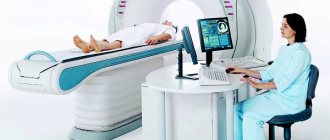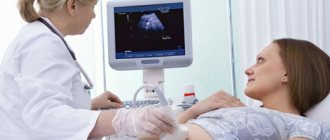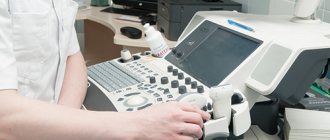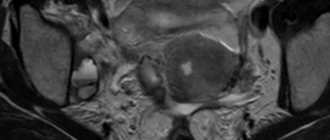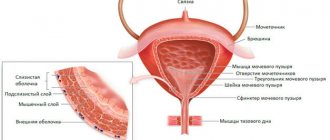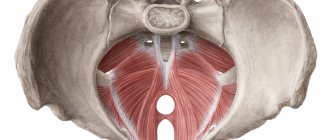- Home >
- Directory >
- Preparing for an MRI exam
All other types of MRI studies (brain, blood vessels, spine, joints, soft tissues, kidneys) do not require special preparation.
MRI is an absolutely painless and harmless procedure. In the vast majority of cases, special preparation for the study is not required. You should prepare in advance for only 3 types of MRI: pelvis, abdominal or when contrast is administered. This is necessary for maximum information content and quality of MR imaging. When you make an appointment for an MRI, the administrator will definitely tell you over the phone again about the preparation in detail.
Preparing for an MRI of the abdomen (belly)
- The day before the test, exclude from the diet coarse fiber (cabbage, etc., fruits), carbonated drinks, brown bread, and fermented milk products that cause gas formation.
- Taking the drug "Espumizan" or "Meteospasmil" during the day before the test, according to the instructions for preparing for diagnostic studies - to eliminate increased gas formation
- The study is carried out on an empty stomach (last meal no later than 6-8 hours before the start of the study)
- You should not drink liquids or smoke 1 hour before the MRI.
Preparation for MRI of the pelvis in women
Features of preparation for MRI of the pelvic organs in women:
- menstrual cycle. MRI is not performed during menstruation. This is due to the fact that at this moment there is too much blood flow to the organs of the reproductive system, so there is a large error in diagnostic results. As a rule, MRI in women is performed on days 7-10 of the cycle;
- daily diet. Preparing for an MRI of the pelvis involves eliminating foods from the diet that can lead to increased gas formation. The list of such products includes carbonated drinks, fermented milk products, black bread, as well as all vegetables that have a high content of coarse fiber;
- Preparation before diagnosis. Approximately 4-6 hours before the procedure you should refrain from eating any food. Immediately before the procedure, the woman needs to go to the toilet, take activated charcoal and drink one antispasmodic tablet.
Preparation for MR imaging of the pelvis
- For female patients of fertile age, MRI is best performed on days 7-12 of the menstrual cycle. The study can also be carried out in the 2nd phase of the cycle. MRI during menstruation is not recommended due to the impossibility of assessing the endometrium.
- Recommendations for MRI of the pelvis correspond to points 1-3 (examination of the abdominal cavity, see above.) You can eat a light meal 3 hours before.
- Bowel preparation: on the day of the examination, the large intestine should be free of contents - laxative tea for constipation in the evening before the examination, or natural emptying of the rectum in the morning on the day of the examination.
- Do not urinate 1 hour before the start of the test (no additional fluid intake is needed), the bladder should be moderately full
- In half an hour to 40 minutes you should take 2-3 tablets. “No-shpy” (not the “forte” form!). We perform MRIs on emergency patients without preparation.
How to prepare for an MRI of the pelvic organs?
MRI of the abdominal cavity and pelvis can be prescribed as a preventive measure, but more often it is necessary for pain, disturbances in the functioning of individual organs, and also for injuries. MRI of the pelvic organs is prescribed to examine both men and women; it allows one to evaluate the anatomical structure of organs in this part of the body and identify any foci of pathology.
“MRI of the pelvic organs does not require long and complex preparation, but there are important nuances that should not be forgotten,” says radiologist at the Light central clinic, Ph.D. Andrey Yurievich Dolmatov.
- take 1 tablet of no-shpa in the evening before the test, 1 tablet in the morning, take 1 tablet with you to take 20 minutes before the test;
- It is advisable to do a cleansing enema before the study;
- for women: MRI of the pelvis is optimally performed on the 2nd dry day after the end of menstruation, but can be performed on any day of the cycle;
- MRI of the abdominal cavity and retroperitoneal space does not require special preparation.
Despite the fact that MRI is considered one of the safest research methods, like other alternative scanning methods, it has contraindications. First of all, the use of this examination method is prohibited in the following cases:
- presence of a pacemaker;
- the presence of metal implants in the body (implanted hearing aids, artificial eyes with a drive, etc.);
- metal plates, other orthopedic structures, various types of clips and metal sutures of any location are a relative contraindication;
- not recommended for pregnant women in the first trimester;
- claustrophobia is a relative contraindication: You need to try it - our device is light, it blows air, it is open on both sides. We try to create the most comfortable conditions for all patients,” notes Andrey Yurievich;
- inability to lie motionless during the examination.
What are the advantages of magnetic tomography?
- Allows you to evaluate the structure and condition of any structures: bone, soft tissue, blood vessels, ligaments and cartilage.
- Obtaining accurate, high-quality images in different planes.
- Allows you to diagnose the slightest changes and anomalies that are invisible on other devices.
You can sign up for an MRI right now by calling Kirov (8332) 711-100, detailed information and prices follow the link.
Central clinic "Light" Kirov, lane. Gostiny, 5/1 OPENING HOURS: Monday to Friday from 7.00 to 22.00 Saturday, Sunday from 8.00 to 19.00 TELEPHONES: (8332) 711-100, 255-100
List of foods not to eat before MRI

Gas-forming products
The diet for an MRI examination of the abdominal cavity is based on eating food that does not cause fermentation processes in the intestines. This list will help you navigate the variety of food products:
| Products that promote increased gas formation |
|
| Foods that cause moderate gas |
|
| Products that cause minor gas formation |
|
Gas-forming foods include sweeteners, fried foods, salted and pickled vegetables, and multi-ingredient salads. On the eve of an MRI, such foods should be avoided.
MR image of the abdominal organs
A certain combination of foods also contributes to the accumulation of intestinal gases:
Fruit juices and sweets with:
- starchy foods;
- salty food;
- protein food.
Dairy products or milk with:
- pickles;
- fish;
- seafood;
- meat;
- bread;
- sour fruits.
- Cereals with vegetables.
- Bread with sausages and sweet juices.
- Meat and potatoes.
- Carbonated drinks with any meal.
- Legumes and rye bread.
Cost of MRI of the pelvic organs
The price of performing an MRI of the pelvic organs at the Patero Clinic may vary depending on the purpose of the procedure. The cost is calculated based on the type of procedure, as MRI can be performed with or without contrast. When calculating the final cost, the patient’s condition and the need to provide various additional services are taken into account.
After completing the activity, the specialist gives a conclusion. If you need to calculate the exact cost of the procedure, please contact our specialists by phone. We will help you find answers to all your questions and make an appointment with the right specialist at a convenient time and day, and calculate the final cost of the diagnosis.
Can I drink alcohol before an abdominal MRI?

Drinking alcoholic beverages is contraindicated before an MRI of the abdominal organs.
Alcohol is strictly contraindicated before magnetic tomography of the abdominal cavity. At least two days before the planned diagnosis, you must completely stop drinking alcohol.
The ban is due to the following reasons:
- The MRI method requires the patient to remain completely still during scanning. An examination of the abdominal organs can last from 30-40 minutes to an hour. It is impossible to predict how a drunk person will behave in a confined space. Therefore, such a patient will simply not be allowed to undergo the procedure.
- Alcoholic drinks put a lot of stress on the liver and gallbladder, which negatively affects the examination results.
- Alcohol is a gas-forming product; after drinking it, flatulence and intestinal upset may occur, which interferes with MRI.
- When diagnosing the abdominal cavity, contrast agents interact with ethyl alcohol molecules, which can worsen the health of the patient.
- In preparation for magnetic resonance imaging, you may need to take antispasmodic medications. Alcohol neutralizes their effect, which will affect the scan results.
- Patients who are terrified of the MRI procedure are given sedatives before the examination. In combination with alcoholic beverages, the opposite to the expected effect cannot be ruled out.
Purpose of MRI of the pelvic organs
You can get an MRI of the pelvis in Moscow at the Patero Clinic. This research method is safe and is often prescribed to identify the causes of gynecological and urological pathologies.
In the process of diagnosing the pelvic organs, the condition of the uterus and appendages, vagina is determined, and the bladder and rectum are examined.
Why is an MRI of the pelvic organs prescribed?
- It is necessary to identify pathologies;
- It is necessary to exclude the presence of malignant tumors;
- Nodes need to be assessed.
Tomography is often performed to assess how effective the prescribed treatment is, especially in oncology. Specialists may order a diagnostic test if cancer is detected. If the presence of neoplasms is confirmed, an MRI of the pelvis with contrast is performed.
In order to obtain the most objective results after the procedure, it is recommended that before arriving at the medical center, take previous examination results and show them to the diagnostician. You should also take with you other documentation that contains objective data about the patient’s health status.
MRI of the pelvis in women is not performed during menstruation. To get the most objective results, a few days before the test you need to exclude foods that increase intestinal motility. Your doctor may recommend a bowel cleanse before the test; you should abstain from liquids several hours before the procedure. You can find out the price of performing an MRI in Moscow in our clinic by calling the number listed on the website.
What foods can you eat before an abdominal MRI?

You can include lean fish and citrus fruits in your diet before an MRI scan of the abdominal organs.
To avoid excessive gas formation, it is recommended to follow a few simple rules:
- eat 5-6 times a day in small portions (do not overeat);
- eat at the same time;
- drink about two liters of water a day;
- reduce salt intake;
- Remove spicy foods from your diet:
- onion;
- garlic;
- pepper;
- Consume fruits and vegetables after heat treatment;
- reduce the amount of carbohydrates.
List of foods that you can eat before an MRI examination of the abdominal cavity:
- cereal porridge on water:
- buckwheat;
- barley;
- pearl barley;
- from whole oats;
- from unpolished rice;
- lean meat, poultry;
- seafood, low-fat fish;
- boiled, baked and stewed vegetables;
- berries;
- greenery;
- prunes;
- hard cheeses with a minimum percentage of fat content;
- black bread (in small quantities);
- citrus;
- soft-boiled eggs (one or two per day);
- water soups, weak broths;
- low-fat fermented milk products:
- cottage cheese;
- fresh kefir;
- yogurt.
Drinks allowed are tea without sugar and still water.
Preparation stages
When going for a scan, you need to perform the following manipulations:
- Light diet. The day before the planned examination, you must avoid foods that cause heaviness in the abdomen and increased formation of gases. It is advisable to free the diet from food components such as flour products and raw vegetables and fruits. It is undesirable to eat food that contains milk protein and sugar. During this period, you can get by with water-based porridges and low-fat soups.
- Colon cleansing. If the scan is scheduled for the morning, the night before you need to naturally clear the intestinal tract (go to the toilet). For constipation, you need to use a laxative or water rinsing with an enema.
- Fasting before the procedure. You must come for MRI diagnostics on an empty stomach.
- Medication preparation. If there is increased formation of gases or spasms, an hour before the examination it is necessary to take a drug that reduces these symptoms (Espumizan, No-shpa).
- Bladder fullness. The patient's gender determines how to prepare for an MRI of the pelvic organs. If you plan to examine the ovaries in women or the glandular organ in men, the bladder should be empty at the time of screening. When scanning the uterus or bladder, the fullness of the organ should be at an average level. You don’t need to consume a lot of liquid; just stop going to the toilet an hour before the procedure.
Pelvic examination using MRI
The MRI procedure begins with the patient entering a special room where the equipment for the study is located. Before starting the procedure, you must remove all jewelry and metal objects. After this, the woman sits on a special table. During the examination, the patient is in a horizontal position. The tomograph operator is located in an adjacent room, carefully monitoring the diagnostic process. Sometimes he gives small commands, for example, for a woman to hold her breath for a few seconds. During an MRI, a person does not feel any discomfort. Some people report feeling warm as the scanner gets closer to the area being examined. This is a completely natural reaction of the body to the influence of a magnetic field. After the study, the woman can return to her usual activities without any problems. As a rule, a conclusion based on the examination results is issued the next day.
Indications and contraindications for pelvic MRI
MRI of the pelvis allows you to study the condition of the internal organs. The diagnostic method is based on the use of electromagnetic waves. The event allows you to obtain reliable information about the dynamic processes in the body.
During the examination, doctors receive detailed data on the condition of the bladder, uterus, fallopian tubes, and intestines. MRI can detect tumors, cystic formations, inflammation, etc.
Indications for implementation:
- Suspicion of cancer;
- There is a history of organ trauma;
- Frequent pain;
- Suspicions of rectal disease;
- There is a risk of developing ovarian cysts;
- Infertility.
The procedure is considered safe, but has a number of limitations. The manipulation should not be performed on patients with installed pacemakers, metal implants and metal-ceramic prostheses. Patient weight restrictions apply. Relative contraindications are claustrophobia, mental disorders, and age under 7 years. Before starting the procedure, you will need to remove all metal objects. The price of performing an MRI of the pelvis can be clarified with our specialists.

